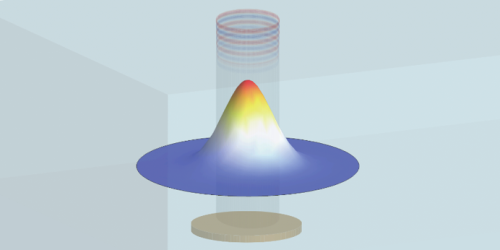Quantum on a Microgram Scale
Quantum physics rules the microscopic world, while classical physics reigns over the macroscopic realm. Power changes hands somewhere in between but exactly how and at what scale is still unknown. A new experiment with an acoustic resonator demonstrates quantum superposition—the simultaneous occupation of two distinct states—in a collection of 1016 atoms, weighing around 1 microgram [1]. The results push the boundary of “quantumness” in near-macroscopic objects, and further refinements could allow these resonators to surpass quantum tests with matter interferometers.
To probe the quantum-to-classical transition, physicists study the size limits of systems where superposition is observed. The traditional test bed is an interferometer in which an object “split” into two separate paths produces an interference signal. The current record for matter interferometry is a molecule with 2000 atoms [2].
An alternative way to observe superposition is with an acoustic resonator, which can be in two vibrational states at the same time. Matteo Fadel from the Swiss Federal Institute of Technology (ETH) in Zurich and his colleagues studied the behavior of a sapphire-crystal resonator that was driven by a superconducting qubit to vibrate in two separate modes. “Observing this superposition, and the rate at which it vanishes, allows us to test the validity of quantum mechanics in our system,” Fadel says.
Although the resonator has many more atoms than interferometry test objects, the vibrational states are separated by a relatively small (subatomic) distance. In terms of macroscopicity—a logarithmic scale used to evaluate quantum tests (see Synopsis: Quantum-ness Put on the Scale)—the researchers’ resonator goes to 11, whereas matter interferometers can reach as high as 14. To improve resonator tests, Fadel and his colleagues propose several changes, including making resonators that vibrate more coherently and at lower frequencies.
–Michael Schirber
Michael Schirber is a Corresponding Editor for Physics Magazine based in Lyon, France.
References
- B. Schrinski et al., “Macroscopic quantum test with bulk acoustic wave resonators,” Phys. Rev. Lett. 130, 133604 (2023).
- Y. Y. Fein et al., “Quantum superposition of molecules beyond 25 kDa,” Nat. Phys. 15, 1242 (2019).




